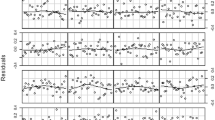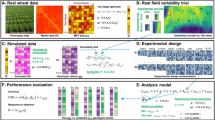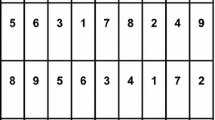Abstract
Key message
Comparing standard errors of treatment differences using fixed or random block effects with the approximation of Kackar and Harville helps in choosing the preferable assumption for blocks in the analysis of field experiments.
Abstract
Blocked designs are common in plant breeding field trials. Depending on the precision of variance estimates, recovery of inter-block information via random block effects may be worthwhile. A challenge in practice is to decide when recovery of information should be pursued. To investigate this question, a series of sugar beet trials laid out as α-designs were analysed assuming fixed or random block effects. Additionally, small trials laid out as α-designs or partially replicated designs were simulated and analysed assuming fixed or random block effects. Nine decision rules, including the Kackar–Harville adjustment, were used for choosing the better assumption regarding the block effects. In general, use of the Kackar–Harville adjustment works well and is recommended for partially replicated designs. For α-designs, using inter-block information is preferable for designs with four or more blocks.
Similar content being viewed by others
References
Beeck CP, Cowling WA, Smith AB, Cullis BR (2010) Analysis of yield and oil from series of canola breeding trials, part I. Fitting factor analytic mixed models with pedigree information. Genome 53:992–1001
Bhattacharya CG (1998) Goodness of Yates-Rao procedure for recovery of inter-block information. Indian J Statist 60:134–144
Brown LD, Cohen A (1974) Point and confidence estimation of a common mean and recovery of interblock information. Ann Statist 2:963–976
Butler DG, Tan MK, Cullis BR (2009) Improving the accuracy of selection for late maturity α-amylase in wheat using multi-phase designs. Crop Pasture Sci 60:1202–1208
Caliński T, Kageyama S (2000) Block designs: a randomization approach. Volume I: analysis. Lecture notes in statistics 150. Springer, New York
Casella G (2008) Statistical design. Springer, New York
Crawford AC, Stefanova K, Lambe W, McLean R, Wilson R, Barclay I, Francki MG (2011) Functional relationships of phytoene synthase 1 alleles on chromosome 7A controlling flour colour variation in selected Australian wheat genotypes. Theor Appl Genet 123:95–108
Cullis BR, Smith AB, Coombes NE (2006) On the design of early generation variety trials with correlated data. J Agric Biol Environ Stat 11:381–393
Federer WT (1956) Augmented (or hoonuiaku) designs. Hawaii Plant Rec 55:191–208
Graybill FA, Deal RB (1959) Combining unbiased estimation. Biometrics 15:543–550
Hickey LT, Lawson W, Platz GJ, Dieters M, Arief VN, Germán S, Fletcher S, Park RF, Singh D, Pereyra S, Franckowiak J (2011) Mapping Rph20: a gene conferring adult plant resistance to Puccinia hordei in barley. Theor Appl Genet 123:55–68
John JA, Williams ER (1995) Cyclic and computer generated designs. Chapman and Hall, London
Kackar AN, Harville DA (1984) Approximation for standard errors of estimators of fixed and random effects in mixed linear models. J Amer Statist Assoc 79:853–862
Kenward MG, Roger JH (1997) Small-sample inference for fixed effects from restricted maximum likelihood. Biometrics 53:983–997
Longin CFH, Gowda M, Mühleisen J, Ebmeyer E, Kazman E, Schachschneider R, Schacht J, Kirchhoff M, Zhao Y, Reif JC (2013) Hybrid wheat: quantitative genetic parameters and consequences for the design of breeding programs. Theor Appl Genet 126:2791–2801
Mead R (1988) The design of experiments. Statistical principles for practical application. Cambridge University Press, Cambridge
Mead R, Gilmour SG, Mead A (2012) Statistical principles for the design of experiments: applications to real experiments. Cambridge series in statistical and probabilistic mathematics. Cambridge University Press, Cambridge
Möhring J, Piepho HP (2009) Comparison of weighting in two-stage analyses of series of experiments. Crop Sci 49:1977–1988
Möhring J, Williams ER, Piepho HP (2014) Efficiency of augmented p-rep designs in multi-environmental trials. Theor Appl Genet 127:1047–1060
Nelder JA (1954) The interpretation of negative components of variance. Biometrika 41:544–548
Patterson HD, Thompson R (1971) Recovery of inter-block information when block sizes are unequal. Biometrika 58:545–554
Patterson HD, Williams ER (1976) A new class of resolvable incomplete block designs. Biometrika 63:83–92
Piepho HP, Möhring J, Schulz-Streeck T, Ogutu JO (2012) A stage-wise approach for the analysis of multi-environment trials. Biom J 54:844–860
Rebetzke GJ, Verbyla AP, Verbyla KL, Morell MK, Cavanagh CR (2014) Use of a large multiparent wheat mapping population in genomic dissection of coleoptile and seedling growth. Plant Biotechnol J 12:219–230
Robinson GK (1991) That BLUP is a good thing: estimation of random effects. Statist Sci 6:15–32
Seshadri V (1963) Constructing uniformly better estimators. J Amer Statist Assoc 58:172–175
Shrikhande SS (1951) Designs for two-way elimination of heterogeneity. Ann Math Stat 22:235–247
Smith AB, Lim P, Cullis BR (2006) The design and analysis of multi-phase plant breeding experiments. J Agric Sci 144:393–409
Stein C (1956) Inadmissibility of the usual estimator for the mean of a multivariate normal distribution. Proc. Third Berkeley Symp. Math. Statist. Prob. 1, University of California Press, Berkeley, pp 197–206
Stein C (1966) An approach to the recovery of inter-block information in balanced incomplete block designs. In: Research Papers in Statistics. Neymann Festschrift FN, David (ed) John Wiley, New York, pp 351–366
Van Eeuwijk FA (1995) Linear and bilinear models for the analysis of multi-environment trials, part I. An inventory of models. Euphytica 84:1–7
Weerakkody GJ (1992) A note on the recovery of inter-block information in balanced incomplete block designs. Comm Stat Theory Methods 21:1125–1136
Williams ER, Piepho HP, Whitaker D (2011) Augmented p-rep designs. Biom J 53:19–27
Williams ER, John JA, Whitaker D (2014) Construction of more flexible and efficient p-rep designs. Aust N Z J Stat 56:89–96
Yates F (1940) The recovery of inter-block information in balanced incomplete block designs. Ann Eugen 10:317–325
Acknowledgments
JM and HPP were supported by DFG grant PI 377/13-1. Strube Research is thanked for providing their dataset. We thank two anonymous reviewers for their helpful hints, which enhanced the quality of this paper.
Conflict of interest
The authors declare that they have no conflict of interest.
Author information
Authors and Affiliations
Corresponding author
Additional information
Communicated by M. Bink.
Appendix
Appendix
See Tables 9, 10, 11, 12 and 13.
Rights and permissions
About this article
Cite this article
Möhring, J., Williams, E. & Piepho, HP. Inter-block information: to recover or not to recover it?. Theor Appl Genet 128, 1541–1554 (2015). https://doi.org/10.1007/s00122-015-2530-0
Received:
Accepted:
Published:
Issue Date:
DOI: https://doi.org/10.1007/s00122-015-2530-0




